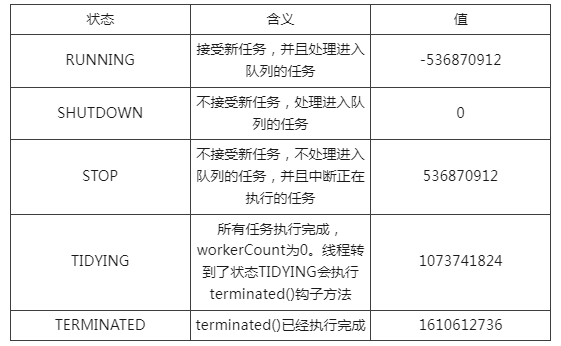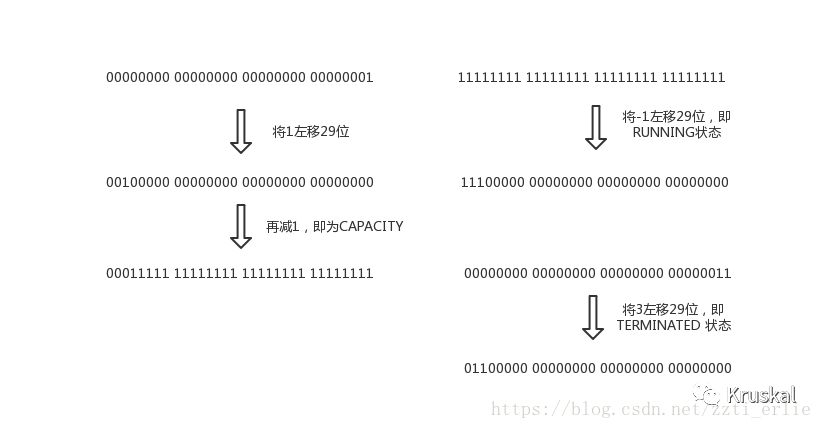线程池实现原理-1
前言
设计到一部分AQS和阻塞队列的内容,可以看一下如下分享
深入理解AbstractQueuedSynchronizer
作用
- 降低资源消耗。通过重复利用已创建的线程降低线程创建和销毁造成的消耗
- 提高响应速度。当任务到达时,任务可以不需要的等到线程创建就能立即执行
- 提高线程的可管理性。线程是稀缺资源,如果无限制的创建,不仅会消耗系统资源,还会降低系统的稳定性,使用线程池可以进行统一的分配,调优和监控
使用
通过Executors类,提供四种线程池

public class Task extends Thread{
@Override
public void run() {
System.out.println(Thread.currentThread().getName() + " is running");
try {
TimeUnit.SECONDS.sleep(1);
} catch (InterruptedException e) {
e.printStackTrace();
}
}
}
public class TestCachedThreadPool {
public static void main(String[] args) {
ExecutorService executorService = Executors.newCachedThreadPool();
for (int i = 0; i < 5; i++) {
Task task = new Task();
executorService.execute(task);
}
//pool-1-thread-1 is running
//pool-1-thread-5 is running
//pool-1-thread-2 is running
//pool-1-thread-4 is running
//pool-1-thread-3 is running
//必须显式结束,不然程序永远不会结束
executorService.shutdown();
}
}这个看起来好像没有用到线程池,其实是因为没有可复用的线程,所以就一直创建新的线程了
public class TestFixedThreadPool {
public static void main(String[] args) {
ExecutorService executorService = Executors.newFixedThreadPool(2);
for (int i = 0; i < 5; i++) {
Task task = new Task();
executorService.execute(task);
}
//pool-1-thread-1 is running
//pool-1-thread-2 is running
//pool-1-thread-1 is running
//pool-1-thread-2 is running
//pool-1-thread-1 is running
executorService.shutdown();
}
}
public class TestScheduledThreadPool {
public static void main(String[] args) {
ScheduledExecutorService executorService = Executors.newScheduledThreadPool(1);
//任务,第1次任务延迟的时间,2次任务间隔时间,时间单位
executorService.scheduleAtFixedRate(new Runnable() {
@Override
public void run() {
System.out.println("task 1 " + System.currentTimeMillis());
}
}, 1, 5, TimeUnit.SECONDS);
//两者互不影响
executorService.scheduleAtFixedRate(new Runnable() {
@Override
public void run() {
System.out.println("task 2 " + System.currentTimeMillis());
}
}, 1, 2,TimeUnit.SECONDS);
//task 1 1521949174111
//task 2 1521949174112
//task 2 1521949176106
//task 2 1521949178122
//task 1 1521949179104
//task 2 1521949180114
}
}
public class TestSingleThreadExecutor {
public static void main(String[] args) {
ExecutorService executorService = Executors.newSingleThreadExecutor();
for (int i = 0; i < 5; i++) {
Task task = new Task();
executorService.execute(task);
}
//pool-1-thread-1 is running
//pool-1-thread-1 is running
//pool-1-thread-1 is running
//pool-1-thread-1 is running
//pool-1-thread-1 is running
executorService.shutdown();
}
}源码

基于jdk1.8.0_20 ,先说一下我的理解,以便对线程池的工作方式有个大概了解,以前我们运行线程的时候new Thread().start()即可,如果线程数多了,频繁的创建线程和销毁线程很费时间,于是Doug Lea将实现了Runnable接口的任务放到一个容器中,然后启动一个线程执行完自己的任务后,还能从容器中拿出任务,调用Runnable接口的run方法,这样一个Thread类就能执行多个任务了,当然可以启动多个线程同时消费容器中的任务,线程池就这样实现了
状态
先了解一下线程池的状态及线程数量的表示方式


private final AtomicInteger ctl = new AtomicInteger(ctlOf(RUNNING, 0));
private static final int COUNT_BITS = Integer.SIZE - 3;
private static final int CAPACITY = (1 << COUNT_BITS) - 1;
// runState is stored in the high-order bits
private static final int RUNNING = -1 << COUNT_BITS;
private static final int SHUTDOWN = 0 << COUNT_BITS;
private static final int STOP = 1 << COUNT_BITS;
private static final int TIDYING = 2 << COUNT_BITS;
private static final int TERMINATED = 3 << COUNT_BITS;
// Packing and unpacking ctl
private static int runStateOf(int c) { return c & ~CAPACITY; }
private static int workerCountOf(int c) { return c & CAPACITY; }
private static int ctlOf(int rs, int wc) { return rs | wc; }AtomicInteger类型的ctl代表了ThreadPoolExecutor的控制状态,是一个复合类型的变量,借助高低位包装了2个概念
- runState 线程池运行状态,占据ctrl的高三位
- workerCount 线程池中当前活动的线程数量,占据ctl的低29位
COUNT_BITS代表了workerCount所占的位数,即29,而CAPACITY表示线程池理论的最大活动线程数量,即536870911

0在Java底层是由32个0表示的,无论左移多少位,还是32个0,即SHUTDOWN的值为0,TIDYING则是高三位为010,低29为0
private static int runStateOf(int c) { return c & ~CAPACITY; }~是按位取反的意思,CAPACITY表示的是高位的3个0,和低位的29个1,而~CAPACITY则表示高位的3个1,和低位的29个0,然后再与入参c执行按位与操作,即高3位保持原样,低29位全部设置为0,也就获取了线程池的运行状态runState
private static int ctlOf(int rs, int wc) { return rs | wc; }传入的rs表示线程池运行状态runState,其是高3位有值,低29位全部为0的int,而wc则代表线程池中有效线程的数量workerCount,其为高3位全部为0,而低29位有值的int,将runState和workerCount做按位或,即用runState的高3位,workerCount的低29位填充的数字
构造函数
从上面例子的代码开始看起
ExecutorService executorService = Executors.newCachedThreadPool();
// Executors
public static ExecutorService newCachedThreadPool() {
return new ThreadPoolExecutor(0, Integer.MAX_VALUE,
60L, TimeUnit.SECONDS,
new SynchronousQueue<Runnable>());
}
// ThreadPoolExecutor
public ThreadPoolExecutor(int corePoolSize,
int maximumPoolSize,
long keepAliveTime,
TimeUnit unit,
BlockingQueue<Runnable> workQueue) {
this(corePoolSize, maximumPoolSize, keepAliveTime, unit, workQueue,
Executors.defaultThreadFactory(), defaultHandler);
}
// ThreadPoolExecutor
public ThreadPoolExecutor(int corePoolSize,
int maximumPoolSize,
long keepAliveTime,
TimeUnit unit,
BlockingQueue<Runnable> workQueue,
ThreadFactory threadFactory,
RejectedExecutionHandler handler) {
if (corePoolSize < 0 ||
maximumPoolSize <= 0 ||
maximumPoolSize < corePoolSize ||
keepAliveTime < 0)
throw new IllegalArgumentException();
if (workQueue == null || threadFactory == null || handler == null)
throw new NullPointerException();
this.corePoolSize = corePoolSize;
this.maximumPoolSize = maximumPoolSize;
this.workQueue = workQueue;
this.keepAliveTime = unit.toNanos(keepAliveTime);
this.threadFactory = threadFactory;
this.handler = handler;
}
这里简单说一下corePoolSize和maximumPoolSize,可以进行如下类比学习,corePoolSize=公司的基本人员,maximumPoolSize=公司的基本人员+外包人员。corePoolSize,保持存活的工作线程的最小数目,当小于corePoolSize时,会直接启动新的一个线程来处理任务,而不管线程池中是否有空闲线程
keepAliveTime是空闲线程的存活时间,默认用于非核心线程,但是当allowCoreThreadTimeOut=true时(这个值默认是false),同样用于核心线程
ThreadFactory是一个工厂类接口,我们可以实现这个接口,来自定义产生线程的方式
public interface ThreadFactory {
/**
* Constructs a new {@code Thread}. Implementations may also initialize
* priority, name, daemon status, {@code ThreadGroup}, etc.
*/
Thread newThread(Runnable r);
}来看一下上面的例子使用的默认的工厂类,这个默认的工厂类是Executors类的一个静态内部类
// Executors
static class DefaultThreadFactory implements ThreadFactory {
private static final AtomicInteger poolNumber = new AtomicInteger(1);
private final ThreadGroup group;
private final AtomicInteger threadNumber = new AtomicInteger(1);
private final String namePrefix;
DefaultThreadFactory() {
// 可以定义代码能访问那些资源的管理器,一般不做设置
SecurityManager s = System.getSecurityManager();
group = (s != null) ? s.getThreadGroup() :
Thread.currentThread().getThreadGroup();
namePrefix = "pool-" +
poolNumber.getAndIncrement() +
"-thread-";
}
public Thread newThread(Runnable r) {
Thread t = new Thread(group, r,
namePrefix + threadNumber.getAndIncrement(),
0);
// 如果是守护进程,设置成非守护进程
if (t.isDaemon())
t.setDaemon(false);
// 设置成一般的优先级
if (t.getPriority() != Thread.NORM_PRIORITY)
t.setPriority(Thread.NORM_PRIORITY);
return t;
}
}在看看上面例子打印的Thread.currentThread().getName(),你是不是知道因为啥了?
RejectedExecutionHandler是一个接口,有4个实现类,对应4种处理策略,这4个实现类是ThreadPoolExecutor的静态内部类

饱和策略接口,当队列和线程池都满了,说明线程处于饱和状态,必须采取策略处理提交的任务,我们可以实现这个接口来自定义处理策略
public interface RejectedExecutionHandler {
// 用executor执行r
void rejectedExecution(Runnable r, ThreadPoolExecutor executor);
}来看上面例子中使用的饱和策略的实现方式,其他策略方式实现也挺简单,不再介绍
// 丢弃任务,抛运行时异常
// ThreadPoolExecutor
public static class AbortPolicy implements RejectedExecutionHandler {
public AbortPolicy() { }
// RejectedExecutionException继承自RuntimeException
public void rejectedExecution(Runnable r, ThreadPoolExecutor e) {
throw new RejectedExecutionException("Task " + r.toString() +
" rejected from " +
e.toString());
}
}ThreadPoolExecutor的各种属性,前面基本上介绍的差不多了
public class ThreadPoolExecutor extends AbstractExecutorService {
// 任务队列,用于保存等待执行的任务的阻塞队列
private final BlockingQueue<Runnable> workQueue;
// Lock held on access to workers set and related bookkeeping.
private final ReentrantLock mainLock = new ReentrantLock();
// 存放线程池中的worker线程,mainLock加锁时才能访问
private final HashSet<Worker> workers = new HashSet<Worker>();
// Wait condition to support awaitTermination
private final Condition termination = mainLock.newCondition();
// 记录线程池达到的最大数量,mainLock加锁时才能访问
private int largestPoolSize;
// 完成任务的计数器,仅在工作线程终止时更新,mainLock加锁才能访问
private long completedTaskCount;
// 用于设置线程的工厂
private volatile ThreadFactory threadFactory;
// 在线程池饱和或者线程池处于shutdown 状态时被调用
private volatile RejectedExecutionHandler handler;
// 当allowCoreThreadTimeOut = true || 当前线程数量 > corePoolSize
// 空闲线程超时等待的时间,否则一直阻塞等待
private volatile long keepAliveTime;
// 为false(默认),核心线程仍然活着,即使在空闲
// 为true,核心线程使用keepAliveTime超时等待工作
// 如果超过keepAliveTime则销毁
private volatile boolean allowCoreThreadTimeOut;
// 核心线程池数量
private volatile int corePoolSize;
// 线程池最大数量
private volatile int maximumPoolSize;
// 默认策略是 丢弃任务,抛运行时异常
private static final RejectedExecutionHandler defaultHandler =
new AbortPolicy();
/*
* 检查是否有modifyThread权限
* Modification of threads, e.g., via calls to Thread
* interrupt, stop, suspend,
* resume, setDaemon, setPriority,
* setName and setUncaughtExceptionHandler
* methods
* This allows an attacker to modify the behaviour of
* any thread in the system.
*/
private static final RuntimePermission shutdownPerm =
new RuntimePermission("modifyThread");
}execute实现
将线程放入线程池有2种方式,一种是execute,一种是submit,这里我们先说一下execute执行流程
- 首先线程池判断基本线程池是否已满?没满,创建一个工作线程来执行任务。满了,则进入下个流程。
- 其次线程池判断工作队列是否已满?没满,则将新提交的任务存储在工作队列里。满了,则进入下个流程。
- 最后线程池判断整个线程池是否已满(即线程数是否小于线程池最大容量)?没满,则创建一个新的工作线程来执行任务,满了,则交给饱和策略来处理这个任务。

简单类比一下创建过程
- 来项目了,如果公司有比较闲的基本人员,则让这些闲的基本人员干活
- 公司的基本人员都有活干,则看看以后的日程排满没?没有,则把这些项目排到日程后面,以后干就行
- 项目太多,以后也没时间干,看看公司还有剩余工位不,有工位,来一个项目招一个外包,工位满了,该经理做决定了,是不接这个项目还是其他做法
public void execute(Runnable command) {
if (command == null)
throw new NullPointerException();
int c = ctl.get();
// 当前线程数<corePoolSize
if (workerCountOf(c) < corePoolSize) {
if (addWorker(command, true))
return;
c = ctl.get();
}
// 线程池处于RUNNING状态,并且任务成功放入阻塞队列
if (isRunning(c) && workQueue.offer(command)) {
int recheck = ctl.get();
if (! isRunning(recheck) && remove(command))
reject(command);
// 线程池处于RUNNING状态,但是没有线程,创建线程
else if (workerCountOf(recheck) == 0)
addWorker(null, false);
}
else if (!addWorker(command, false))
reject(command);
}执行到addWorker(null, false)这个方法说明,任务刚来的时候核心线程都在工作,结果它就被放到阻塞队列中了,然后核心线程都执行完了(并且都被销毁了),如果不调用一下这个方法,则放到阻塞队列中的任务就不会被执行
核心线程不是一直都存在的吗?为什么会被销毁了,这还得从一个属性allowCoreThreadTimeOut说起,这个属性默认是false,意思是核心线程不会被销毁,如果设置为ture,则在workQueue为空的时候,核心线程有可能全被销毁了
reject其实就是根据我们设置的策略,来处理无法运行的任务
final void reject(Runnable command) {
handler.rejectedExecution(command, this);
}文章转载自公众号:Java识堂




















